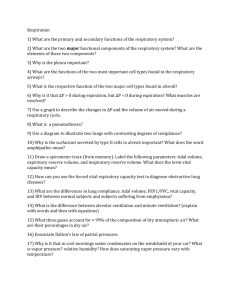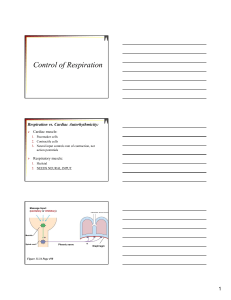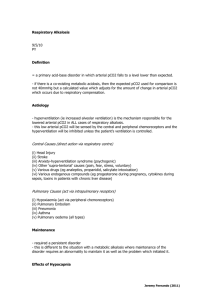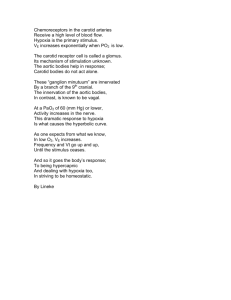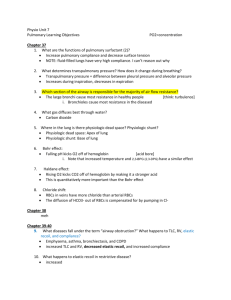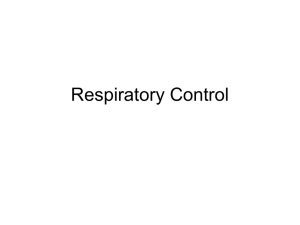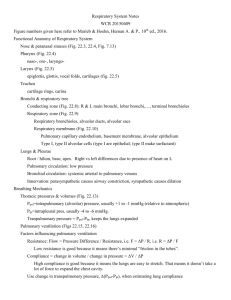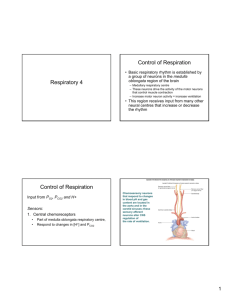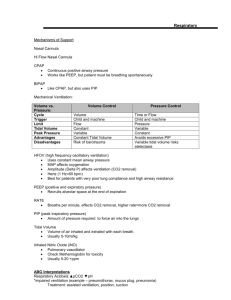CASE 20
advertisement
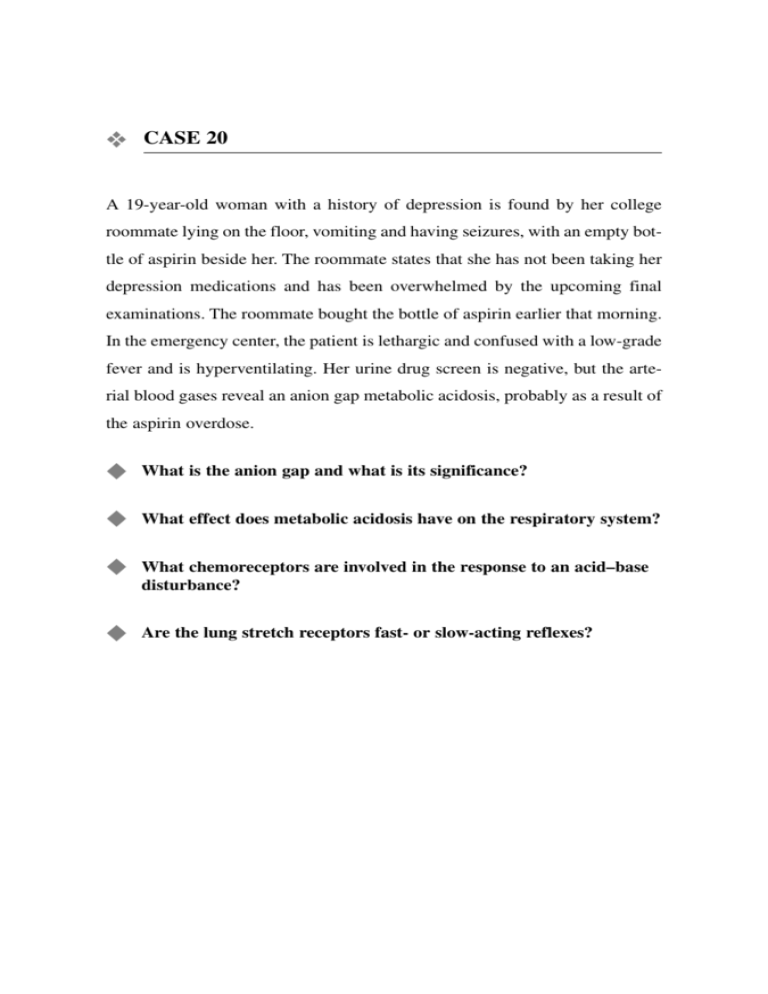
❖ CASE 20 A 19-year-old woman with a history of depression is found by her college roommate lying on the floor, vomiting and having seizures, with an empty bottle of aspirin beside her. The roommate states that she has not been taking her depression medications and has been overwhelmed by the upcoming final examinations. The roommate bought the bottle of aspirin earlier that morning. In the emergency center, the patient is lethargic and confused with a low-grade fever and is hyperventilating. Her urine drug screen is negative, but the arterial blood gases reveal an anion gap metabolic acidosis, probably as a result of the aspirin overdose. ◆ What is the anion gap and what is its significance? ◆ What effect does metabolic acidosis have on the respiratory system? ◆ ◆ What chemoreceptors are involved in the response to an acid–base disturbance? Are the lung stretch receptors fast- or slow-acting reflexes? 164 CASE FILES: PHYSIOLOGY ANSWERS TO CASE 20: CONTROL OF BREATHING Summary: A 19-year-old college student with a history of depression presents to the emergency center with salicylate poisoning and an anion gap acidosis. ◆ ◆ ◆ Significance of the anion gap: Anion gap = [Na+] − ([Cl−] + [HCO3-]). An increase in the rate of production (eg, lactic acid or ketoacids) or ingestion of noncarbonic acids or substances that increase lactic acid or ketoacid production will cause a decrease in the plasma concentration of bicarbonate. The anion gap helps identify the type of acidosis and estimate the magnitude of the acid load to the system. Effect of metabolic acidosis on the respiratory system: Increases ventilation to lower the arterial [CO2] to compensate for the fall in plasma pH. Chemoreceptors involved in response to an acid–base disturbance: Two groups of chemoreceptors respond to a metabolic acidosis: 1. Peripheral chemoreceptors located in the carotid bodies detect changes in arterial [H+], [CO2], and [O2]. 2. Central chemoreceptors located on the medulla (reticular segment). They are separated from the blood by the blood–brain barrier and detect changes in the arterial [CO2]. ◆ Lung stretch receptors: Slow-acting reflexes. CLINICAL CORRELATION Overdosing on over-the-counter medications is a commonly seen problem in emergency centers. A thorough history and physical examination often will reveal clues necessary to make the diagnosis. In this case, the history of depression with stressful final examinations coming up and an empty bottle of recently purchased aspirin make one think of the possibility of salicylate poisoning. Salicylate poisoning may cause clinical symptoms of vomiting, sweating, tachycardia, fever, lethargy confusion, coma, seizures, cardiovascular collapse, and possibly pulmonary or cerebral edema. Salicylate ingestion can cause a multitude of effects, depending on the magnitude of the ingestion. A complication is that salicylates can alter metabolic processes, causing an increase in lactic acid production, and directly stimulate central respiratory centers, causing hyperventilation and a fall in arterial PCO2. Symptoms usually occur 3 to 6 hours after an overdose. Abnormal laboratory findings may include anion gap metabolic acidosis, hypokalemia, hypoglycemia, and a positive urine ferric chloride test. Other agents are also possible, including acetaminophen, alcohol, and illicit drugs. Treatment of salicylate toxicity includes activated charcoal to decontaminate the stomach (possibly gastric lavage), correction of CLINICAL CASES 165 electrolyte abnormalities, supportive care with intravenous (IV) fluids, and alkalization of urine (promotes excretion of salicylates). Elevated levels of salicylates increase the sensitivity of the respiratory center in the brain. The metabolic acidosis results in hyperventilation and a compensatory respiratory alkalosis. APPROACH TO CONTROL OF BREATHING Objectives 1. 2. 3. Know the central and peripheral centers for control of breathing. Describe the different types of chemoreceptors. Know the different types of receptors (lung stretch, irritant, etc.). Definitions Respiratory center: Located in the reticular formation of the medulla it is responsible for maintaining a rhythmical cycle of breathing and integrating neural input from a variety of receptors (e.g. central and peripheral chemoreceptors) to adjust the rate and depth of breathing in response to perturbations in environmental or physical conditions. Central chemoreceptors: Located in the ventrolateral surface of the medulla directly respond to a change in the pH of the CSF, however, since the blood brain barrier is impermeable to either H+ or HCO3-, these receptors detect changes in the arterial PCO2. Peripheral chemoreceptors: Located on the carotid and aortic bodies these receptors respond directly to changes in the arterial pH, PCO2, and PO2. CO2 / HCO3- buffering system: The central buffering system in the body for maintaining H+ homeostasis. The importance of this buffering system is the ability to control the arterial PCO2 by pulmonary function and [HCO3-] through renal function to compensate for acid-base disturbances. DISCUSSION The pH of the arterial blood is normally 7.4 and is dependent mainly on the CO2 / HCO3- buffering system in the blood: CO2 + H2O Æ H2CO3 Æ H+ + HCO3The control of the pH, or hydrogen ion homeostasis is dependent on an interaction of the respiratory control of arterial PCO2 and renal control of arterial HCO3- and H+ excretion. Acid–base disturbances are generally identified as being of respiratory or metabolic origin. Respiratory acid–base disorders are a consequence of a respiratory disturbance that results in a change 166 CASE FILES: PHYSIOLOGY in the arterial PCO2. Until the disturbance is corrected, renal function will compensate the disruption. Metabolic disturbances are the consequence of a change in the arterial pH caused by initial changes in [H+] or [HCO3-]. The respiratory system serves to compensate for metabolic disturbances. The respiratory system is finely tuned to and highly sensitive to changes in CO2 and H+. The O2 concentration is an important regulator, but has a minimal role until the arterial PO2 falls to less than 55 to 60 mm Hg. Acid–base disturbances have immediate effects on respiration caused by specific chemoreceptors that are sensitive to changes in CO2, H+, and O2. This case involves a metabolic acidosis caused by the ingestion of an acidic substance. The respiratory system can compensate for this disturbance only by controlling the CO2 concentration and shifting the equilibrium of the CO2/HCO3- buffering system and maintaining hydrogen ion homeostasis. Acid–base balance is markedly disturbed, as indicated by the anion gap. Acid–base balance can be restored only by renal excretion of the acid and reabsorption of HCO3- (see Case 27 for the renal response to an acid–base disturbance). Respiration is spontaneously and rhythmically initiated by the respiratory center located in the reticular formation of the medulla. Neural signaling to the inspiratory and expiratory muscle groups maintains the cycle of breathing. Numerous mechanisms are capable of modifying the signal to alter the frequency and depth of breathing in response to voluntary stimuli, reflexes and other neural stimuli, and a variety of chemical or mechanical stimuli. Acid–base disturbances are characteristically identified by their effects on plasma pH, PCO2, and [HCO3-]. Chemoreceptors located centrally and in the periphery respond to changes in arterial pH and PCO2 with input to the respiratory center that causes compensatory changes in breathing. Peripheral chemoreceptors are located in the carotid bodies and the aortic bodies and detect changes in pH, O2, and to a lesser extent PCO2. Under normal conditions, O2 has little role in the control of ventilation. However, under hypoxic conditions in which the PO2 begins to approach 50 mm Hg or lower, O2 stimulates ventilation directly and increases sensitivity to H+ and CO2. Impulses from the peripheral chemoreceptors are carried by the glossopharyngeal nerve to the respiratory center. Stimulation of the peripheral chemoreceptors causes an increase in ventilatory rate. Central chemoreceptors located on the medulla are separated from the blood by the blood–brain barrier. These receptors are bathed by the cerebrospinal fluid (CSF), which is essentially a pure bicarbonate buffer. Because the blood–brain barrier is impermeable to H+ and HCO3- but freely permeable to CO2, a change in the arterial CO2 will cause a change in the CSF CO2 with a concomitant change in the CSF pH. Thus, although directly sensing a change in CSF pH, central chemoreceptors respond to changes in the arterial PCO2. A fall in the arterial PCO2 (hypocapnia) will increase the CSF pH and slow respiration. An increase in the arterial PCO2 (hypercapnia) will decrease the CSF pH and stimulate respiration. CLINICAL CASES 167 Physiologically, a metabolic acidosis or an initial decrease in pH (an increase in H+) stimulates the peripheral chemoreceptors, resulting in hyperventilation. The hyperventilation leads to a compensatory fall in PCO2. Normally, the magnitude of the hyperventilation is limited and controlled by a negative feedback from the central chemoreceptors, which detect only a decrease in PCO2. This important control mechanism serves to dampen the respiratory response to an acid–base disturbance. In the present case of salicylate intoxication, there also may be a direct stimulation of the respiratory center that will cause a further increase in the respiratory rate with a resultant respiratory alkalosis (hypocapnia) superimposed on the metabolic acidosis. This example emphasizes the importance of the interactions between the central and peripheral chemoreceptors. A metabolic alkalosis will have exactly the opposite response. The peripheral chemoreceptors respond to an increased pH (a fall in H+) by slowing ventilation with a compensatory rise in PCO2. The rise in arterial PCO2 is sensed by central chemoreceptors, which respond with an increase in the ventilatory rate to dampen the response. In disorders in which one or the other chemoreceptor is blocked or nonfunctional, severe aberrations in breathing patterns are observed. In addition to the chemoreceptors outlined above, there are three receptor groups that are located in the lungs. J-receptors (juxtapulmonary capillary receptors) are located in the interstitium near alveoli and blood capillaries. Increasing pressure in the interstitium by edema or capillary engorgement stimulates J-receptors, causing bronchoconstriction and tachypnea. Irritant receptors are located in the airways between epithelial cells. They are located in such a way that they have immediate contact with inhaled air and are stimulated by cigarette smoke, dust, fumes, and cold air. Stimulation of irritant receptors leads to bronchoconstriction, hyperpnea, coughing, and sneezing. Pulmonary stretch receptors are located in airway smooth muscle and are stimulated by distention of the lung and serve to protect the lungs against being overinflated. COMPREHENSION QUESTIONS [20.1] A 17-year-old male develops pneumonia, diabetic ketoacidosis, and metabolic acidosis. Respiratory compensation to a metabolic acidosis consists of hyperventilation to lower the arterial PCO2. The cause of the hyperventilation is described by which of the following statements? A. CO2 produced from the reaction of the acid with bicarbonate stimulates central chemoreceptors. B. A decrease in the bicarbonate concentration stimulates ventilation. C. H+ stimulates central chemoreceptors. D. H+ stimulates peripheral chemoreceptors. 168 [20.2] CASE FILES: PHYSIOLOGY A 21-year-old woman is admitted to the intensive care unit for an opiate drug overdose that probably has suppressed her central chemoreceptor response to CO2, diminishing the drive for ventilation. Her respiratory rate is diminished at eight breaths per minute. Which of the following is the best course of action for this patient? A. B. C. D. [20.3] Administration of oxygen by mask Administration of benzodiazepine for possible alcohol withdrawal Leaving the patient on room air Placing the patient on a low opiate infusion to prevent opiate withdrawal A 29-year-old man who lives at sea level drives up a mountain to a high altitude (17,000 feet) for over 3 hours. Which of the following statements best describes his condition after the elevation climb? A. B. C. D. Increased arterial PO2 Decreased arterial PCO2 Decreased arterial pH Decreased respiratory rate Answers [20.1] D. A common mistake is thinking that elevated CO2 produced by the reaction of the acid with bicarbonate is the stimulus for ventilation. To the contrary, as soon as the peripheral chemoreceptors sense an increase in the H+, there will be an immediate increase in the rate of ventilation. The hyperventilation lowers the alveolar PCO2, which lowers the arterial PCO2. This is the appropriate compensatory response because the initial perturbation was a decrease in the bicarbonate concentration from the acid insult. From the Henderson-Hasselbalch equation, it is apparent that a fall in the bicarbonate concentration can be compensated most rapidly by a proportionate fall in CO2. [20.2] C. Because of the narcotic effect, the central receptors are insensitive to CO2; therefore, CO2 exerts no ventilatory drive. The only drive for ventilation is the fall in O2 resulting from the near cessation of breathing. Applying oxygen will remove the remaining drive for ventilation, and breathing will stop. Thus, room air with oxygen saturation monitoring is the best action. Medications that further suppress respirations, such as sedatives (benzodiazepines, opiates, hypnotics), are contraindicated. [20.3] B. The partial pressure of oxygen decreases with increasing altitude. Rapid ascent to high altitude can result in hypoxia. The hypoxia stimulates pulmonary ventilation to increase alveolar PO2. A consequence of the hyperventilation is to decrease the PCO2, or hypocapnia. The fall in CO2 shifts the equilibrium of the CO2/HCO3- buffer system to decrease the H+, resulting in a respiratory alkalosis. CLINICAL CASES 169 PHYSIOLOGY PEARLS ❖ ❖ ❖ The rate and depth of respiration are controlled by a neural feedback loop that involves central chemoreceptors in the medulla and peripheral chemoreceptors in the aortic and carotid bodies. Central chemoreceptors are separated from the blood by the blood–brain barrier and detect changes in arterial [CO2]. Peripheral chemoreceptors respond directly to [H+], CO2, and O2. The concentration of CO2 in the blood is controlled by the alveolar PCO2. Hyperventilation decreases the PCO2, and hypoventilation increases the PCO2. Raising the arterial [CO2] causes a hyperventilation with a compensatory decrease, and lowering the [CO2] causes a hypoventilation. The main buffer system in the body is the CO2/HCO3− buffering system. One of its components, CO2, is controlled by the ventilatory rate; therefore, one of the most effective ways of compensating for an acid or base disturbance is to alter the [CO2] in the blood. Increasing H+ stimulates ventilation, which lowers CO2. Conversely, a fall in [H+] slows ventilation, resulting in a rise in [CO2]. REFERENCE Powell FL. Structure and function of the respiratory system. In: Johnson LR, ed. Essential Medical Physiology. 3rd ed. San Diego, CA: Elsevier Academic Press; 2003:259-276. This page intentionally left blank
